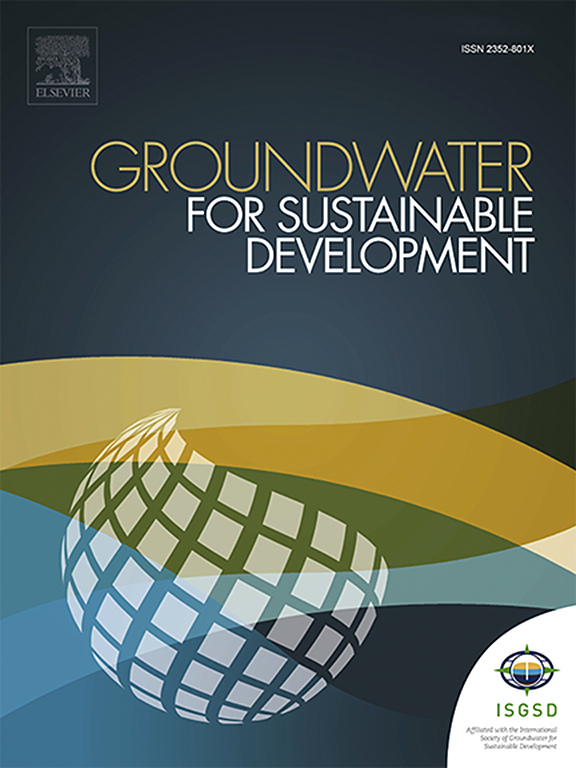History and assessment of household Arsenic Biosand Filter interventions in Nepal: Over two decades of efforts and challenges
IF 4.9
Q2 ENGINEERING, ENVIRONMENTAL
引用次数: 0
Abstract
Arsenic contamination found in groundwater poses a significant number of health risks, particularly within rural regions of developing countries. In Nepal, the introduction of the Arsenic Biosand Filter (ABF) as a household-level intervention aimed to mitigate arsenic exposure in the arsenic-affected Terai region. Despite its initial promise, questions remain regarding the filter's long-term performance, user awareness, and the sustainability of its dissemination. This study examines the historical development, implementation, and current status of ABFs in the Nawalparasi West District—a commonly known arsenic hotspot—over more than two decades. It is conducted through an integrated review of past documentation; oral histories of involved personnel; and household surveys, which includes an evaluation of filter performance. Among 1044 active ABFs tested, 17 % of raw water samples from tube wells exceeded 50 μg/L, while 4.3 % of filtered water samples still failed to meet Nepal's standard. Filter effectiveness decreased linearly as arsenic concentrations increased. While arsenic contamination in groundwater was generally limited, highly contaminated areas were concentrated in specific locations, necessitating targeted interventions that can effectively address localized risks. Findings reveal low arsenic awareness among users (80 % of which being unaware) and significant disparities in the provided filters, which were linked to both user maintenance practices and supply chain quality. Nevertheless, the study underscores the contributions of local initiatives and scale-up efforts in advancing sustainable arsenic mitigation through coordinated actions and entrepreneurship in the dissemination of ABFs. The results advocate for improved awareness programs targeted at groups with lower educational attainment, enhanced product monitoring by coordinating agencies, and affordable water quality testing mechanisms to ensure long-term sustainability.

尼泊尔家庭砷生物沙过滤器干预措施的历史和评估:二十多年的努力和挑战
地下水中发现的砷污染造成了大量的健康风险,特别是在发展中国家的农村地区。在尼泊尔,砷生物沙过滤器(ABF)作为一项家庭干预措施的引入,旨在减轻受砷影响的Terai地区的砷暴露。尽管它最初的承诺,问题仍然是关于过滤器的长期性能,用户意识和传播的可持续性。本研究考察了纳瓦尔帕拉斯西地区(一个众所周知的砷热点地区)20多年来ABFs的历史发展、实施和现状。它是通过对过去文件的综合审查来进行的;有关人员的口述历史;还有家庭调查,其中包括对过滤器性能的评估。在检测的1044个活性abf中,17%的管井原水样品超过50 μg/L,而4.3%的过滤水样品仍未达到尼泊尔标准。随着砷浓度的增加,过滤效果呈线性下降。虽然地下水中的砷污染总体上是有限的,但高污染地区集中在特定地点,需要有针对性的干预措施,以有效解决局部风险。调查结果显示,用户对砷的认识较低(其中80%不知情),所提供的过滤器存在显著差异,这与用户维护实践和供应链质量有关。尽管如此,该研究强调了地方倡议和扩大努力的贡献,通过协调一致的行动和企业精神,在推广ABFs方面促进可持续的砷缓解。研究结果提倡提高教育程度较低群体的意识,加强协调机构对产品的监测,并建立负担得起的水质检测机制,以确保长期的可持续性。
本文章由计算机程序翻译,如有差异,请以英文原文为准。
求助全文
约1分钟内获得全文
求助全文
来源期刊

Groundwater for Sustainable Development
Social Sciences-Geography, Planning and Development
CiteScore
11.50
自引率
10.20%
发文量
152
期刊介绍:
Groundwater for Sustainable Development is directed to different stakeholders and professionals, including government and non-governmental organizations, international funding agencies, universities, public water institutions, public health and other public/private sector professionals, and other relevant institutions. It is aimed at professionals, academics and students in the fields of disciplines such as: groundwater and its connection to surface hydrology and environment, soil sciences, engineering, ecology, microbiology, atmospheric sciences, analytical chemistry, hydro-engineering, water technology, environmental ethics, economics, public health, policy, as well as social sciences, legal disciplines, or any other area connected with water issues. The objectives of this journal are to facilitate: • The improvement of effective and sustainable management of water resources across the globe. • The improvement of human access to groundwater resources in adequate quantity and good quality. • The meeting of the increasing demand for drinking and irrigation water needed for food security to contribute to a social and economically sound human development. • The creation of a global inter- and multidisciplinary platform and forum to improve our understanding of groundwater resources and to advocate their effective and sustainable management and protection against contamination. • Interdisciplinary information exchange and to stimulate scientific research in the fields of groundwater related sciences and social and health sciences required to achieve the United Nations Millennium Development Goals for sustainable development.
 求助内容:
求助内容: 应助结果提醒方式:
应助结果提醒方式:


